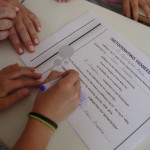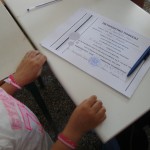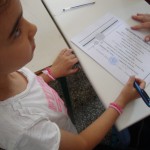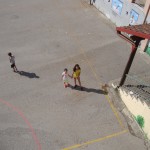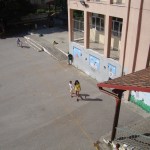2nd ACTION: «Expressing feelings by painting»
(EVALUATION OF A 1st PHASE INTERVENTION FOR A REGULAR TRANSITION )
Responsible teacher: Tsantzou Helen
The teacher, Mrs. Tsantzou Helen, following the actions of acquaintance and familiarization of the infants with the new environment of the Primary School implemented by the members of the pedagogical team participating in the Erasmus + program, proceeded to a next level.
With the help of the children of the 4th grade and in cooperation with the Director Mrs. Lafara Anastasia, Dimitriadou Maria and Nikolaou Polyxeni, in a friendly and loving climate that was cultivated among other things through the participation of the infants in the exhibition of paintings of the school, she asked the infants to paint. They were asked to «talk» about how they feel about changing school and coming to elementary school, to talk, as Vygotsky says, about their own personal story (Brooks, 2009). To give with their paintings a message, to communicate their code, their contact (Goodnow, 1977). To draw emotions, experiences, but also to solve the possible problems and all these naturally incorporated in the context of their transition to the new school environment, the elementary school (Rudolph & Arheim, 1974).
The children of 4th Class on the other hand took part in the whole process of expressing the feelings of infants with paintings, creating a friendly and emotional atmosphere. Through well-organized and targeted facilitating questions and discussions with infants with immediacy, spontaneity of age, and responsibility as a product of prior preparation, they helped infants relax and express their feelings through painting.
The questions that were used were:
– What are you painting?
– How do you feel about changing school?
– What makes you nervous?
– What makes you happy?
– What would you like your class to have?
– would you like to have a Mr or a Mrs as a teacher? How would you like him or her to be?
At the end of the activity, when the teacher Mrs. Tsantzou asked the infants to give her their drawing as a memento, they all gladly accepted to do so.
When the infants returned to kindergarten, the working groups of the 4th grade pupils filled out the replies – statements given by the infants during the activity on a worksheet.
Then, the children’s paintings were evaluated on the basis of the study by Evi Crotti & Alberto Magni » How to Interpret Children’s Drawings – The Children’s Secret Language «. Evi Crotti, a psychologist and educator, and Alberto Magni, a physician with psychosomatic, forensic and psychotherapy, argue that «The needs of a young child, which may not be expressed in words, clearly leave their traces on paper: designs, colours, smudges … «.
Within the above interpretive framework, the elements of a painting that show anxiety and insecurity (Crotti & Magni, 2004) are:
? Very intense and repeated erasure.
? Illustrations low on the page (Figures 1 and 3)
? Unusually small drawings (Fig. 1)
? Gentle colors
? Excessive shade (fig.3)
? Lack of symmetry in the drawings (Fig. 2)
Some of these elements were observed in three drawings:
Fig. 1
Fig. 2
Fig. 3
Elements that show feelings of security and self-confidence are:
? Colours in the center of the page or high on the page
? Certain clear lines
? Bright and vibrant colors
? Big-sized designs
? Smiling faces
? Illustration of large trees with outstretched branches and obvious roots
The majority of infants’ designs had enough of these elements.
What the children ‘paintings said’ were also confirmed by the infants themselves in their interview (See presentation: «EXPRESSING FEELINGS THROUGH PAINTING «)
The coding, analysis and exploration of open-ended and closed-type questions was done through holistic approaches to the context that co-ordinates the understanding of things. They have been processed using the method of speech analysis, which allows for in-depth investigation and interpretation in relation to the causes that led the subjects to express specific views or behaviors and not only in relation to the content of thoughts, opinions and their practices (Cohen, Manion, 1994. Iosifidis, 2003).
Initially, a critical review of the questions selected to strengthen the participants was attempted in the belief that the human factor can change his own life and trust the prospect that the environments can become developmental. Research is approached in the belief that the action of researchers is able to maximize self-awareness as a player in everyday life as a catalyst for positive change, thus gaining a dialectic distance from events (Bogdan & Bilken, 1982. Kincheloe, 2003 ). Thus, through the understanding that leads to the interpretation of behaviors and attitudes, it is possible to discover the possibilities for a change.
In addition, people choose their language or the repertoires they will use depending on what they want to achieve each time and in relation to the specific conditions, eventually constructing a version of reality among many others (Potter & Wetherell, 1987) the reliability and validity of research is the result of statistical processing and careful analysis and interpretation (Mishler, 1996).
The material of the present study is 14 questionnaires distributed to adults, parents of infants, as well as notes from previous pilot discussions (Bell, 1997. Cohen, Manion, 1994. Filias, 2000)
Infants-questionnaires
The theoretical approach to the issues that were initially evaluated and re-evaluated as important and necessary to understand and interpret the phenomenon of transition from the kindergarten to elementary school, initially formed the axes of the interview that was to be structured, including as simple as possible and understandable questions that give answers about research goals (Bell, 1997). Of course, the free conversations that preceded with people of the nearby environment of the infants, wherever possible, helped (Cohen, Manion, 1994).
The collection of the material that took place in June 2018, followed by statistical data processing and statistical analysis (Filia, 2000), which led to the following results:
Conclusions of action
Evaluation of the Phase Intervention Program
Infants with their paintings «declared» in their majority optimistic and happy about coming to the Primary School. On the 8th of June 2018, the action had almost completed the first phase of the intervention program for their smooth transition. The educational team that implemented it interpreted the results of the activity as an indicator of the achievement of its objectives.

